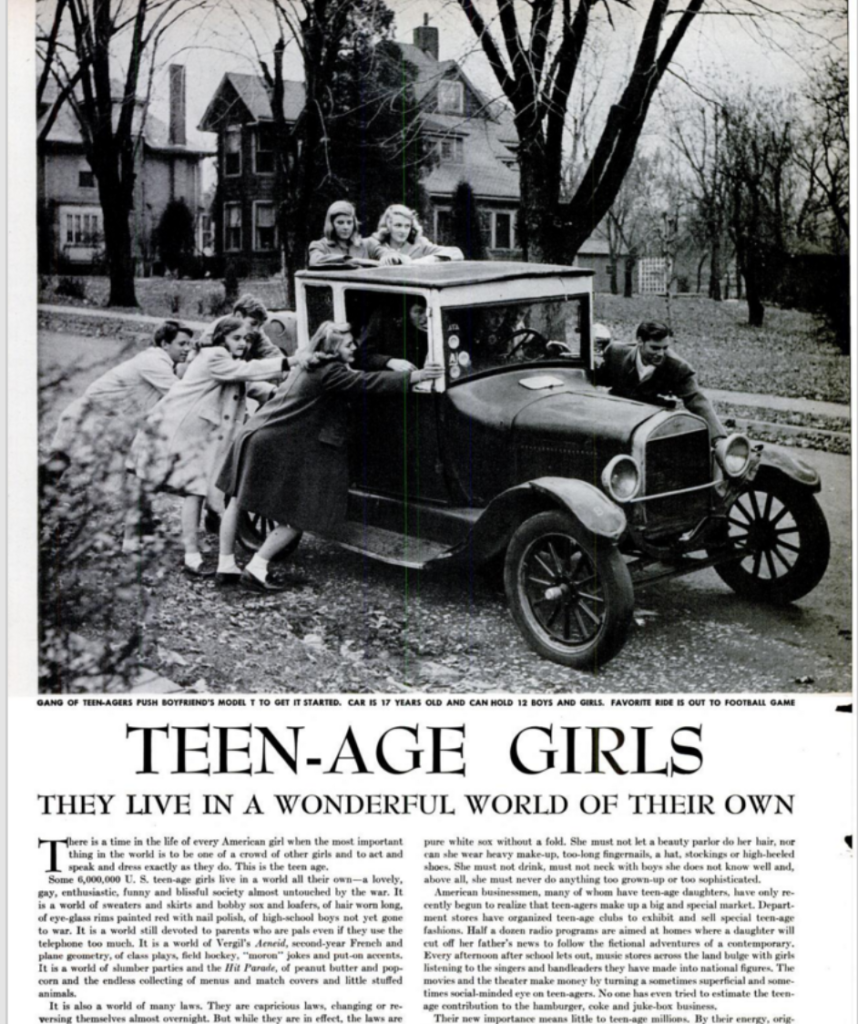By Pam Thurschwell
“Some 6,000,000 U.S. teen-age girls live in a world all their own — a lovely, gay, enthusiastic, funny and blissful society almost untouched by the war. It is a world of sweaters and skirts and bobby sox and loafers, of hair worn long, of eye-glass rims painted red with nail polish, of high school boys not yet gone to war. It is world still devoted to parents who are pals even if they use the telephone too much. It is a world of Virgil’s Aeneid, second-year French and plane geometry, of class plays, field hockey, “moron” jokes and put-on accents. It is a world of slumber parties and the Hit Parade, of peanut butter and popcorn and the endless collecting of menus and match covers and little stuffed animals.”
“Teen-Age Girls: They Live in a Wonderful World of Their Own” Life Magazine, 1944.
While researching my book on adolescent temporality I found myself transfixed by a photo essay from a 1944 Life Magazine called “Teen-Age Girls: They Live in a Wonderful World of Their Own”. The photo essay portrays a sea of happy, white, middle class, mostly blonde, American girls doing all the things we associate with the bobby-soxer: dates, sodas, high school football games. The photos and captions give the reader a sense of the divide between adults and young people that becomes more noticeable around the 1940s. The article has a tongue-in-cheek anthropological tone; the teenager seems like an alien intruder with a strange set of rituals and habits. 1940s teenagers are pictured as confusing to their parents’ generation who grew up without access to that identity. The Life Magazine story makes it seem as if to understand modern teenagers, adult readers need to be anthropologists of their own children, studying them to try to understand their newly emerging culture.

During the course of the 20th century adolescence goes from being seen as a potentially troubling and anarchic stage everyone passes through to an identity category bound up with consumption and style. We know that adults are often anxious about the potential radical rebellions of adolescence – think about contemporary panics over youth radicalization for instance. Simultaneously youth as a stage has often been romanticized—either as blissful innocent idleness or safely navigable anarchic rebellion. Adult society anxiously criminalises the behaviour of teenagers, feeling it needs to keep a close watch on them, while at the same time idealizing adolescence, and wanting to remain in it. There are paradoxes that gather around adult attitudes toward the teenager in every time period. Are teenagers sloths (hiding in their rooms or apathetically on their phones) or are they dangerous revolutionaries? Are they where we now put the possibility of fun, play, adventure, or where we unload all our most troubling fears for the future?
From the mid 20th century onwards, youth begins to become an object of desire in itself, rather than just a stage of life to be endured. This shift accompanies more possibilities for young people to spend time together in public space, at dances, in clubs or schools or hanging around on street corners. Jon Savage’s book Teenage charts this change all over Europe, tracing the ways adolescents claim new kinds of freedom and organise in new forms. Changes in education laws in Europe and America feed this change. From the 1870s in England when education becomes compulsory, public funding for schools meant that children stayed in schools for longer. Conscription during both world wars also played a part in prolonging the space before entering the adult world of work. Adolescents had more leisure time and eventually more money to spend. At this point adolescence morphs into a shiny new identity: the teenager.
Before the 1940s then, there are no “teenagers” but many of the concerns and worries that we find about teenagers and how they are spending their time, are clearly apparent much earlier, from the end of the 19th century when we find growing concerns about adolescents’ leisure time and activities and how adults can be sure they grow up properly into certain socially sanctioned directions and not others. The Life Magazine article features something we probably want to call fun; there is a lot of hanging out in packs with friends, at the record store, at the soda fountain, at the drive in movie. But this fun is shot through with rigidly disciplinary gender and sex expectations for teenage girls who are negotiating this new identity. Notice especially the “sandwich girl” “who is considered a real crumb” in the words of the Life Magazine photo caption. Pictured surrounded by boys in a diner, the sandwich girl allows her body to be in too close proximity to boys and puts herself in the centre of the picture. Life asserts this will not go unnoticed: “girls will not invite her to their hen parties and will try act cool towards boys who formed sandwich.” Is Life simply reflecting or is it helping to create this punishment of the new teenage girl at its centre?
Adolescence transforms into modern teenage identity at this (very white, very middle class, very American) Life Magazine moment. What kinds of data re-animation might allow us to understand this movement from adolescent phase to fashion-conscience, consumer oriented, explicit teenage girl identity we see in the process of sexualisation here? What kinds of stories come into play alongside the visualization, celebration, and punishment of the teenage girl emerging here in the 1940s? How does data like this, obviously faulty, idealised, light-hearted and depressingly creepy still matter?
